Abstract. The flora of eastern China forms the main part of Sino-Japanese florislic region. From an analysis of the components it can he seen that the floristic relationships of eastern China with Japan are closer to than they are with northeast China and Korea. The similarity indices of genera and species of seed plants in the two regions are very high, being 72.6% and 43.3% respectively. The structure and species composition of the broadleaved evergreen forests in the two regions are also similar, with corresponding communities, such as the forests of Castanopsis carlesii and C. sieboldii. Many plants in eastern China are conspecific with those in Japan, e. g. Cercidiphyllum japonicum, Magnolia sieboldii, Nandina domestica etc. Though the genera Ginkgo, Liriodeiidron, Sassafras, and others which now exist in China are extinct in Japan, their fossils have been discovered in Tertiary strata in Japan. This evidence seems to indicate that the phytogeographical affinities between Japan and eastern China were closer in ancient times than they are now, and that the forest floras of the two areas originated from the same ancestral flora. The flora of Japan did not evolve independently until it separated from the Chinese continent and drifted northeastward during the late Tertiary.
Key words. phytogeographical affinity, forest flora, eastern China, Japan.
Eastern China is one of the richest regions in plant life in eastern Asia and its flora forms the main part of Sino-Japanese floristic region, and region that has attracted the attention of many botanists both at home and abroad (Hu, 1926, 1929. 1936; Li, 1950, 1953; Steward, 1958; J. X. Wang, 1986, 1988; W. T. Wang, 1992; S. G. Wu, 1987; Z. Y. Wu, 1979; Xie, 1991a, 1991b, 1993). Although a number of papers dealing with eastern Asian-eastern North American phytogeographical relationships have been published (Boufford and Spongberg, 1983), the floristic relations between eastern China and Japan has been rarely reported in detail until now.
Comparison and analysis of the forest floras
The floristic relationships between eastern China and Japan (especially southern Japan) are very close. Based on my preliminary statistics, the similarity indices for families, genera and species of seed plants in the two regions are very high. Some aspects about the phytogeographical affinities can be analyzed as follows.
The floras of the two regions have numerous shared families and genera. The number of families of seed plants in eastern China is 198, while in Japan it is 197. Approximately 81.2% of these families are represented in both regions. Many families endemic to eastern Asia within Sino-Japanese floristic region are monotypic or oligotypic (Table 1).

There are more endemic families of eastern China in common with Japan (seven families) than there are with Korea (two families). Ten families endemic to eastern Asia are distributed in eastern China, including three families endemic to China, but none of these families occurs in northeast China, indicating that the floristic relations of eastern China with Japan are closer than they are with Korea and northeast China. Moreover, this point of view is supported by an analysis of genera and species as follows.
The generic disjunct distribution phenomenon (Good, 1974) between two regions is a most prominent feature that can indicate the degree of similarity of the two areas. The coefficient of similarity of spermatophyte genera between eastern China and Japan is 72.6%. The genera in eastern China in common with Japan and Korea (Table 2) can be classified into 13 distribution types. Table 2 shows that the flora of eastern China has extensive relationships with most parts of the world (Xie, 1991b): the main distribution patterns of seed plants with relationships to Japan and Korea are eastern Asian, pantropical and north temperate; there are more genera in common between eastern China and Japan than there are between eastern China and Korea.

Of special interest are the 66 genera with disjunct distributions in eastern China, Japan and North America. Among these are Magnolia. Illicium, Hamamelis, Phryma and Saururus, etc. Geological history seems to indicate that the formation of this disjunct distribution phenomenon has resulted from plate tectonics, continental drift (Z. Y. Wu, 1983), and global and regional climatic changes.
A high degree of endemism is another prominent feature of the Sino-Japanese floristic region (Takhtajan, 1969; Ying and Zhang, 1984). The region is not only rich in endemic families as shown in Table 1, but also includes an abundance of ancient endemic genera and species as well. There are more than 20 genera endemic to eastern China, including Ginkgo, Pseudolarix, Pseudotaxus, Monimopetalum, Changium, Speiranlha, Brachystachyum, Changnlenia, etc. These genera, which are nearly all relictual and monotypic, show the ancient nature of this flora. The endemic genera in Japan and Korea may be only 17 and 8 respectively, and there are no endemic genera common to both Japan and Korea. But in the eastern (or southeast) China and Japan, there are more than 12 endemic genera shared by the two regions, for example, Disanthus Platycrater, Kirengeshoma, Pterygopleurum, Tanakea, Deinanthe, and so on (Fig. 1). Obviously, this disjunct distribution has been brought about by changes that have taken place throughout geological history. In addition, there are three times as many eastern Asian endemic genera in eastern China and Japan as there are shared between eastern China and Korea, or northeast China, or with Taiwan.
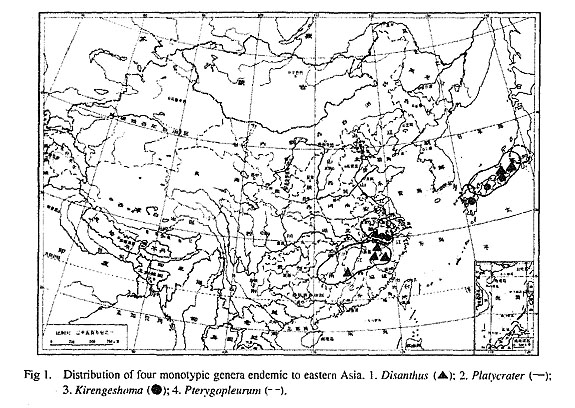
The structure and species composition of the broadleaved evergreen forests in eastern China and Japan (especially in the southern part) are also similar. The corresponding communities and species (trees) are shown in Tables 3 and 4.
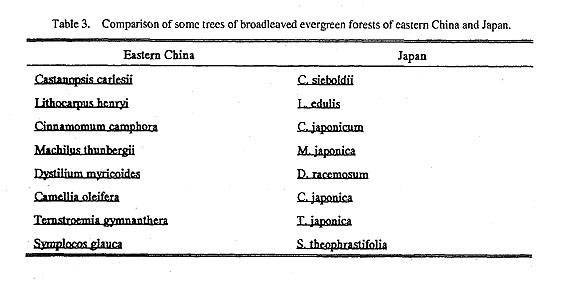
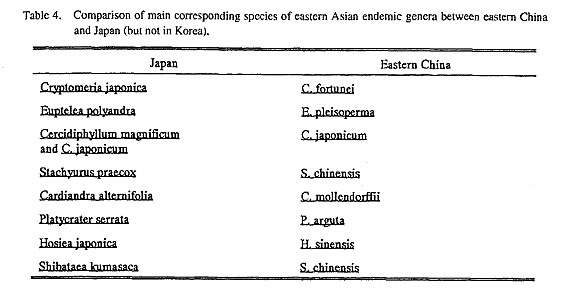
Species shared between eastern China and Japan are numerous; the coefficient of similarity of species of seed plant in the two regions being 43.3%. Furthermore, other species now treated as distinct are so similar that further analysis may show them to be conspecific. Many plants in eastern China are conspecific with those in Japan, but not with those in Korea or in northeastern China, e. g. Cercidiphyllum japonicum, Nandina domestica, Disanthus cercldifolius, Kirengeshoma palmata, Orixa japonica, etc. In some corresponding species, such as Cryptomeria japonica (in Japan) and C. fortunei (in eastern China), it is still a question whether they should be treated as distinct or merged into a single species. According to L. C. Li's (1987) study of Cryptomeria the karyotypes are very similar, although Ihe karyotype of C. japonica shows slightly more advanced features than that of C.fortunei.
The close relationships and parallel evolution of many plants in eastern China and Japan are also associated with similar climatic conditions in the two areas (Table 5). Differentiation and speciation are of great interest in biology. Although the forest floras of eastern China and Japan had a common origin before the Quaternary, the Japanese flora has evolved independently since these islands separated from the southeast
China mainland and drifted northeast. Therefore, there are many endemic elements occurring in the Japanese flora, but these elements seldom occur in Korea. At the same time, some elements in Japan with close relatives in eastern China have differentiated gradually and evolved in parallel, as shown in Table 6.
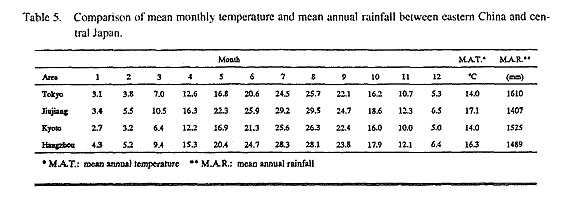
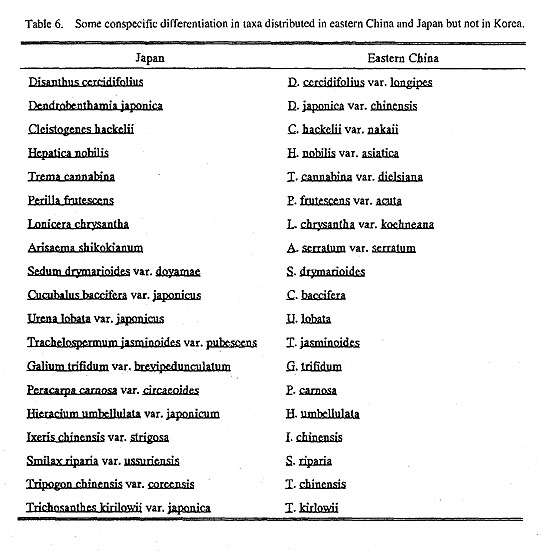
Conclusions and Discussion
The flora of eastern China comprises the main part of the Sino-Japanese floristic region. Based on a comparison and analysis of the floristic elements within the region, some aspects of the phytogeographical affinities of the forest floras of eastern China and Japan can be summarized as follows.
The phytogeographical relationships between eastern China and Japan are much closer than they are between eastern China and Korea or northeast China. Moreover, previous theories on the regionalization of the Japan-Korea floristic province may be unsound. It appears that the Japanese flora should be delimited as an independent floristic province because the floristic relations between Japan and Korea may be not be closer than between Japan and eastern China; many endemic genera and corresponding species in eastern China occur in Japan, but not in Korea; there are essentially no endemic genera in Japan in common with Korea. These observations imply that the floras of Japan or Korea have had their own separate developmental route.
The close floristic relationships between eastern China and Japan are due to a long, shared geological history, which extends back to the Tertiary, not to plant dispersal after the separation of Japan from the continent, nor to a drop in sea level during the ice ages of the Quaternary. Information from geology and paleontology shows that Japan was connected to eastern China and not to Korea. Although the genera Ginkgo, Liriodendron, Sassafras, etc., which are still extant in eastern China, are extinct in Japan, their fossil leaves, fruits and seeds have been discovered in Tertiary strata in Japan, indicating: 1) that the phytogeographical affinities between Japan and eastern China were closer in ancient times than they are now; and 2) that the forest floras of the two areas had a common origin.
Based on the common origin of the forest floras in eastern China and Japan, and their high degree of similarity and endemism, it may be inferred that the flora of Japan did not evolve independently until Japan separated from the Asian continent and drifted northeast in the late Tertiary.
References
- Boufford. D. E. and S. A. Spongberg. 1983.
- Eastern Asian-Eastern North American phytogeographical relationships-a history from the time of Linnaeus to the twentieth century. Ann. Missouri Bot. Gard. 70: 423-439.
- Good, R. 1974.
- The geography of the flowering plants. 4 th ed. Longman Group Ltd., London.
- Hu, H. H. 1926.
- A preliminary survey of the forest flora of southeastern China. Contr. Biol. Lab. Sci. Soe. China. 2: 1-20.
- ——— 1929.
- Further observation of the forest flora of southeastern China. Bull. Fan. Mem. Inst. Biol. 1: 51-52.
- ——— 1936.
- The characteristics and affinities of Chinese flora. Bull. Chinese Bot. Soc. 2: 67-84.
- Li. H. L. 1950.
- Floristic significance and problems of eastern Asia. Taiwania. 1: 1-5.
- ——— 1953.
- Endemism in ligneous flora of eastern Asia. Proc. 7 th Pacific Sci. Congr. (New Zealand) 5(Bot.): 212-216.
- Li, L. C. 1987.
- A preliminary study on the karyotypes and their evolutionary levels of Taxodiaceae's endemic plants to China and neighbouring area. Acta Bot. Yunnan. 9:325-331. (m Chinese, English abstract)
- Numata, M. (editor). 1974.
- The flora and vegetation of Japan. Kodansha Ltd. Tokyo.
- Qian, H. 1989.
- A study on the floristic relations between the northern part of Dabie Mountains in Anhui and the adjacent floristic regions. J. Wuhan Bot. Res. 7: 39-48.
- Steward, A. N. 1958.
- Manual of vascular plants of the lower Yangtze Valley China. Intern. Acad. Prin. Co. Ltd., Tokyo.
- Takhtajan, A. 1969.
- Flowering plants, origin and dispersal. Authorised translation from the Russian by C. Jeffrey. Oliver and Boyd, Edinburgh.
- Wang, J. X. 1988.
- Relationship of the forest floras among Zhejiang. Taiwan provinces in China and Japan. J. Wuhan Bot. Res. 6: 121-128.
- Wang, W. T. 1992.
- On some distribution patterns and some migration routes found in the eastern Asiatic region. Acta Phytotax. Sin. 30: 1-24; 97-117.
- Wu. S. G. 1987.
- The phytogeographical affinities of pteridophytes between China and Japan. Acta Bot. Yunnan. 9: 167-179.
- Wu, Z. Y. 1979.
- The regionalization of Chinese flora. Acta Bot. Yunnan. 1: 1-22. (in Chinese, English abstract)
- ——— 1983.
- On the significance of pacific intercontinental discontinuity. Ann. Missouri Bot. Gard. 70: 577-590.
- Xie, G. W. 1991a.
- Studies on the woody floristic components and characters of Jiangxi. Bull. Bot. Res. 11(1): 91-99.
- ——— 1991 b.
- A study on the floristics of Mt. Yunjushan in north Jiangxi. Acta Bot. Yunnan. 13:391-401.
- ——— 1993.
- Studies on the floristics of the tropical plants in Jiangxi. J. Wuhan Bot. Res. 11:130-136.
- Ying, T. S. and Z. S. Zhang. 1984
- Endemism in the flora of China-studies on the endemic genera. Acta Phytotax. Sin.22:259-268.






